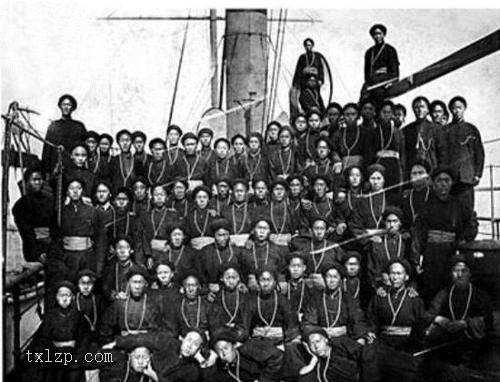Period:Unknown Production date:10thC-12thC
Materials:jade, gold,
Technique:polished, carved,
Dimensions:Height: 2.80 centimetres Length: 4.70 centimetres
Description:
Pair of white jade apsaras of even colour polished to a good gloss.
IMG
![图片[1]-figure BM-2022-3034.212-China Archive](https://chinaarchive.net/Unknown/Jades/656_.jpg)
Comments:The apsaras with hands clasped and wearing bracelets are flying on stylised clouds with up-swept feet and long robes and scarves swirling around their shoulders. The hair, tied into topknots and with flowing hair swept back from the head. The reverse sides are also worked to reflect the back of the apsaras. The flowing hair on one of the pieces is broken and lost, the hair on the other is held with a small gold sheet. Sung. Tang or Liao dynasty, 9thC-10thC. This pair of curved earrings is carved in openwork, each representing a heavenly being flying into the wind. The figures wear small caps on their heads, and scarves and a a skirt that twists around them. Below them are small rolling clouds forming a chain. From the head of one figure, as if a strand of hair, rises a curved pin for insertion in an ear. It has been broken at some point in the past and is held together with a wrapping of gold leaf. The other figure has a hole in its head into which a pin, now lost, would have been inserted. The fine quality of the jade attests to the high value of these pieces. The theme of heavenly beings and the style in which they are represented show the influence of Central Asian forms which were introduced to China from kingdoms further west. Spectacular examples of heavenly beings are found in the sixth-century cave 285 at Dunhuang in Gansu province. Such relatively early examples are depicted without cloud supports. During the Tang such beings were almost invariably shown with tri-lobed colouds , which in the tenth century became a continuous rolling cloud. This development is roughly paralleled in jade. Thus ornaments of deities with detached lobed cloud sections are earlier than the present pieces. Whilst it is probable that the forms of the present earrings and many like them are based upon those employed to depict Buddhist heavenly beings, it is likely that the figures represent Jade Maidens of so-called Daoist transcendent worlds. The very pure white jade is suggestive of the luminous white that is always linked with the immortals worlds of religious Daoism in Tang poetry. Moreover, Jade Maidens have a much larger role in Tang literature than Buddhist heavenly beings or fei tian. See Rawson 1995, p.333, cat.no.25.6.
Materials:jade, gold,
Technique:polished, carved,
Dimensions:Height: 2.80 centimetres Length: 4.70 centimetres
Description:
Pair of white jade apsaras of even colour polished to a good gloss.
IMG
![图片[1]-figure BM-2022-3034.212-China Archive](https://chinaarchive.net/Unknown/Jades/656_.jpg)
Comments:The apsaras with hands clasped and wearing bracelets are flying on stylised clouds with up-swept feet and long robes and scarves swirling around their shoulders. The hair, tied into topknots and with flowing hair swept back from the head. The reverse sides are also worked to reflect the back of the apsaras. The flowing hair on one of the pieces is broken and lost, the hair on the other is held with a small gold sheet. Sung. Tang or Liao dynasty, 9thC-10thC. This pair of curved earrings is carved in openwork, each representing a heavenly being flying into the wind. The figures wear small caps on their heads, and scarves and a a skirt that twists around them. Below them are small rolling clouds forming a chain. From the head of one figure, as if a strand of hair, rises a curved pin for insertion in an ear. It has been broken at some point in the past and is held together with a wrapping of gold leaf. The other figure has a hole in its head into which a pin, now lost, would have been inserted. The fine quality of the jade attests to the high value of these pieces. The theme of heavenly beings and the style in which they are represented show the influence of Central Asian forms which were introduced to China from kingdoms further west. Spectacular examples of heavenly beings are found in the sixth-century cave 285 at Dunhuang in Gansu province. Such relatively early examples are depicted without cloud supports. During the Tang such beings were almost invariably shown with tri-lobed colouds , which in the tenth century became a continuous rolling cloud. This development is roughly paralleled in jade. Thus ornaments of deities with detached lobed cloud sections are earlier than the present pieces. Whilst it is probable that the forms of the present earrings and many like them are based upon those employed to depict Buddhist heavenly beings, it is likely that the figures represent Jade Maidens of so-called Daoist transcendent worlds. The very pure white jade is suggestive of the luminous white that is always linked with the immortals worlds of religious Daoism in Tang poetry. Moreover, Jade Maidens have a much larger role in Tang literature than Buddhist heavenly beings or fei tian. See Rawson 1995, p.333, cat.no.25.6.
© Copyright
The copyright of the article belongs to the author, please keep the original link for reprinting.
THE END

![[Qing Dynasty] British female painter—Elizabeth Keith, using woodblock prints to record China from the late Qing Dynasty to the early Republic of China—1915-China Archive](https://chinaarchive.net/wp-content/uploads/2022/11/image-191x300.png)



